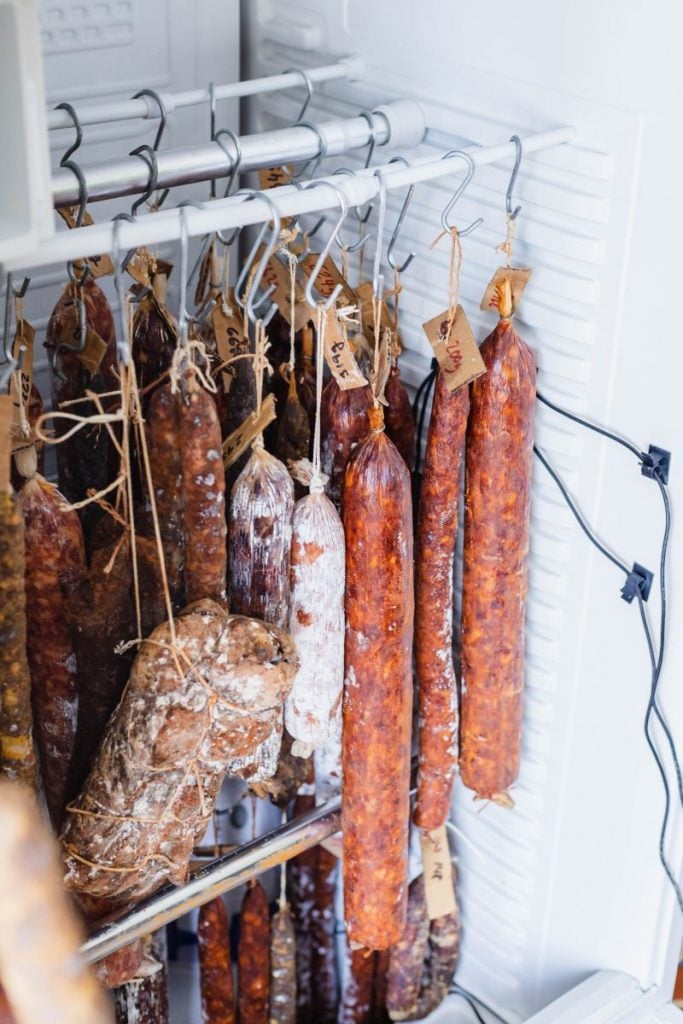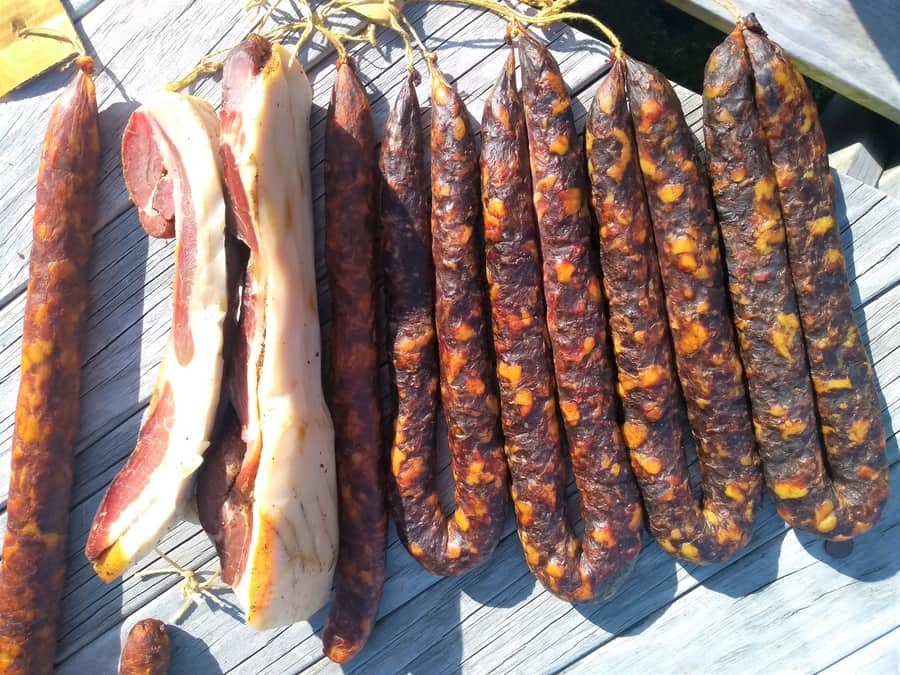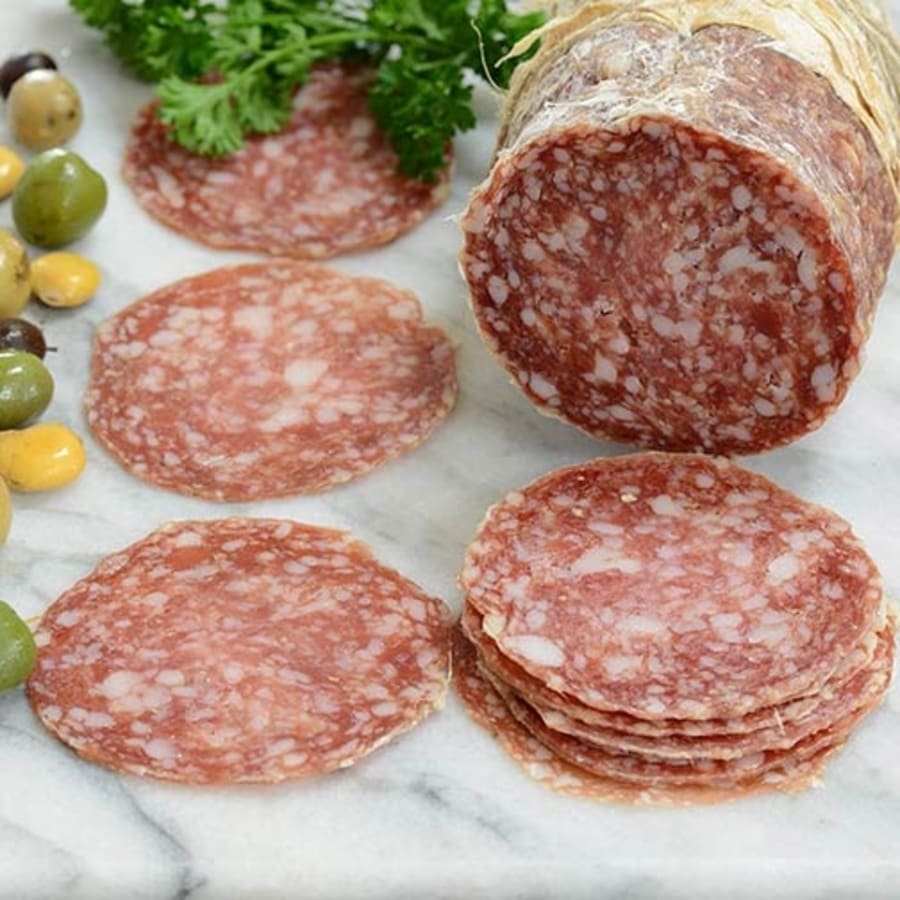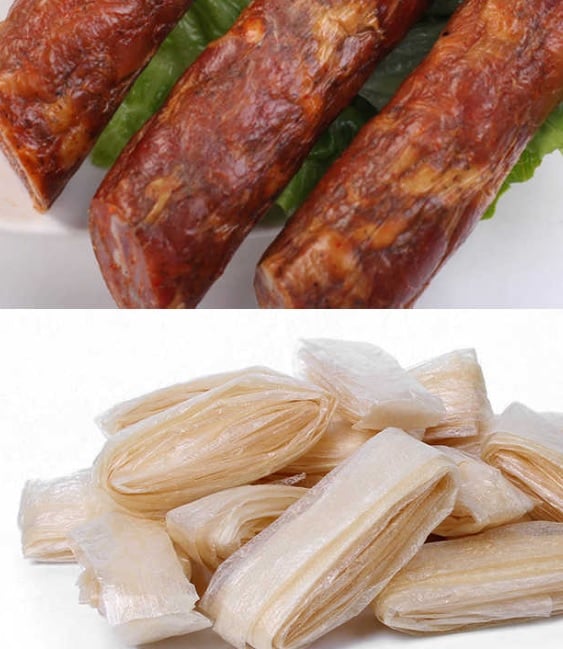Many different casings can be used for wrapping salami. Since I make salami, study it, and teach it – I’ve discovered all the different types available.
Different types of salami wrappings or casings as they are known – are used for other purposes, especially in commercial salami production.
There are thousands of variations of salami across the world. In some areas of the world, like Central and Eastern Europe, the term sausages is also used for salami.
Specifically, I will talk about dry-cured salami, which is the salami that is cured with salt and spices, often fermented and sometimes smoked.
The primary salami type worldwide is either dry-cured or fast commercial-cured salami.

This type of salami (cooked/uncooked salami I wrote about) should traditionally be dried out, which takes a few months, depending on the size.
Many commercially made salamis will increase the acid pH to skip the long traditional process and get the product to market quickly.
This is all about wrapping, so here is a quick summary and some details on the different types below.
What is Salami Wrapped In?
Salami is wrapped in casings that are either from animals, artificial or plant-based. Traditional salami casing is made of animal intestines because they shrink during drying. Some casings are edible, but plastic casings are not – often, they are printed on.
What is the White Stuff on Salami?
Hopefully, that white stuff is penicillin. Yeah, I know that sounds pretty crazy, but it is kind of the same penicillin you find used in hospitals.
The penicillin naturally occurs around the meat, although the mold culture is generally introduced to commercial or homemade salamis. It can be naturally encouraged with high humidity and moderate temperature (and, of course, a process and other factors).
It isn’t always good to mold penicillin, though, you will see, especially on a cheap salami. For some reason, certain commercial producers have been allowed to fake the good mold; white flour is used on the outside to make it look like the real deal.
Another trick to make a salami look authentic is that some commercial products use a plastic-based casing with a picture of good mold penicillin. I’ve seen this trick even throughout supermarkets in Italy!
Different Types of Salami Wrappings
- Natural
- Cellulose Fibrous
- Collagen
- Plastic
It’s nothing to be grossed out by salami wrappings; many are derived from animals, meaning they are natural.
Some I have used in a pure natural casing form, while others have been processed to create something uniform, like collagen casings. Which also uses a byproduct of the animal.
I guess this is efficient utilization or ‘head to tail’ use of an animal.
It’s sad how we’ve moved away from offal and other bits of the animal. Ie. Livers, hearts, etc. I think it has to do with the supply chain; offal is best fresh – any because meat has to go through a ‘process’ that takes time.
Unless you go out and harvest your meat.
Considering the rich amount of vitamins and minerals available in offal and non-steak cuts, it’s a shame.
We’ve been a little bit brainwashed by steak marketing in many countries.
Take bone broth, for instance. It is well-proven scientifically to be incredibly good for you or just old-fashioned chicken stock.
1. Natural Casings
edible
The intestines or casings I use come salted to preserve them, and then you soak them in water. They can be bought online from many places nowadays.
What is it made from?
There are small and large casings that are used for traditional salami wrapping.
The small intestines would be used from sheep and certain parts of the cow.
Large casings are also from the cow, depending on which area they are harvested from.
Example of Natural Casings

Shrinks with the Meat When Drying
One of the most important reasons why natural casings work so well with salami (cut and whole salami storage is also different) wrapping. Are they drying out and shrinking at the same time as the meat is drying out?
Airflow and a natural taste all help the drying process of salami.
This is a crucial step, and why traditionally made salami will have a natural casing.
Curved Natural & Wonky!
Beef casings can sometimes have a curve; I think I’ve also come across this with sheep casings. Of course, being a natural animal product, you don’t know it can be curved until you fill it with delicious meat.
You have probably had a fresh mince meat-type brat sausage with a curve or bend in it – that’s a natural casing, more than likely!
Heard of Haggis from Scotland?
The traditional haggis is Scotland’s most respected and honored tradition, with an exciting mixture of meat, spices, and other products stuffed into a sheep’s stomach. Just a random fact: it’s generally poached until cooked, not a Scottish salami!
2) Cellulose/Fibrous Casings
-nonedible
Common Examples are commercial pepperoni salami and commercial summer sausage.
What are they made from?
“Fibrous casings are made with plant fiber in the form of cellulose, non-meat glycerin, added moisture, and food oil running lengthwise, which gives them added strength.”
Fibrous or cellulose casings have the breathability or permeability to dry things like summer sausage.
These usually come with one end tied, and being nonedible is the type of casings or wrappings you need to peel off.

3. Collagen Casings
- edible
What are they made from?
Connective Tissue, skin, and bones (often cattle hide derived)
I have also come across client-based collagen casings; there are a lot of variations, some edible, some nonedible.

The home producer found it more challenging to work with them on the natural casings, although it depends on the supplier since there are many variations.
4. Plastic Casings
nonedible
What are they made from?
There are many plastic-based products, but not so much for salami since the casing can’t breathe or is not generally permeable.
More for luncheon sausage and mortadella-type products.
What Casing Do Fresh Sausages Use?
These are the sausages that are minced meat with spices.
Since you won’t be peeling off the wrapper of your fried or grilled sausage and you’ll find a little bit of a kink bend in them, this would show that they are natural sausages (like a brat)
Now, if you are researching natural casings and what to go to a new depth –
Check out this authority – International Natural Sausage Casing Association!

Tom Mueller
For decades, immersed in studying, working, learning, and teaching the craft of meat curing, sharing the passion and showcasing the world of charcuterie and smoked meat. Read More
